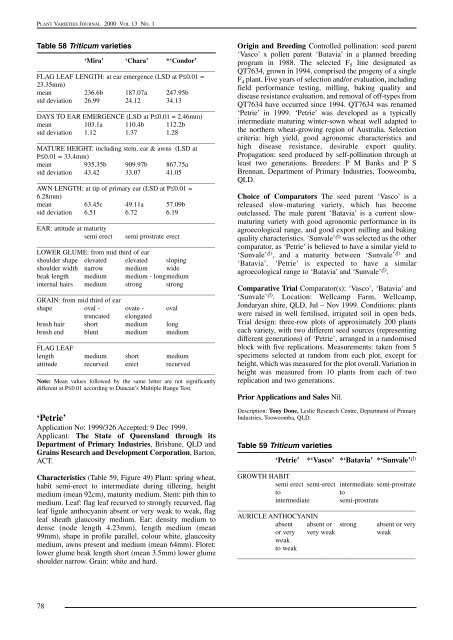53. Volume 13- Number 1 - IP Australia
53. Volume 13- Number 1 - IP Australia
53. Volume 13- Number 1 - IP Australia
Create successful ePaper yourself
Turn your PDF publications into a flip-book with our unique Google optimized e-Paper software.
PLANT VARIETIES JOURNAL 2000 VOL <strong>13</strong> NO. 1<br />
Table 58 Triticum varieties<br />
‘Mira’ ‘Chara’ *‘Condor’<br />
____________________________________________________<br />
FLAG LEAF LENGTH: at ear emergence (LSD at P≤0.01 =<br />
23.35mm)<br />
mean 236.6b 187.07a 247.95b<br />
std deviation 26.99 24.12 34.<strong>13</strong><br />
____________________________________________________<br />
DAYS TO EAR EMERGENCE (LSD at P≤0.01 = 2.46mm)<br />
mean 103.1a 110.4b 112.2b<br />
std deviation 1.12 1.37 1.28<br />
____________________________________________________<br />
MATURE HEIGHT: including stem, ear & awns (LSD at<br />
P≤0.01 = 33.4mm)<br />
mean 935.35b 909.97b 867.75a<br />
std deviation 43.42 33.07 41.05<br />
____________________________________________________<br />
AWN LENGTH: at tip of primary ear (LSD at P≤0.01 =<br />
6.28mm)<br />
mean 63.45c 49.11a 57.09b<br />
std deviation 6.51 6.72 6.19<br />
____________________________________________________<br />
EAR: attitude at maturity<br />
semi erect semi prostrate erect<br />
____________________________________________________<br />
LOWER GLUME: from mid third of ear<br />
shoulder shape elevated elevated sloping<br />
shoulder width narrow medium wide<br />
beak length medium medium - longmedium<br />
internal hairs medium strong strong<br />
____________________________________________________<br />
GRAIN: from mid third of ear<br />
shape oval - ovate - oval<br />
truncated elongated<br />
brush hair short medium long<br />
brush end blunt medium medium<br />
____________________________________________________<br />
FLAG LEAF<br />
length medium short medium<br />
attitude recurved erect recurved<br />
____________________________________________________<br />
Note: Mean values followed by the same letter are not significantly<br />
different at P≤0.01 according to Duncan’s Multiple Range Test.<br />
‘Petrie’<br />
Application No: 1999/326 Accepted: 9 Dec 1999.<br />
Applicant: The State of Queensland through its<br />
Department of Primary Industries, Brisbane, QLD and<br />
Grains Research and Development Corporation, Barton,<br />
ACT.<br />
Characteristics (Table 59, Figure 49) Plant: spring wheat,<br />
habit semi-erect to intermediate during tillering, height<br />
medium (mean 92cm), maturity medium. Stem: pith thin to<br />
medium. Leaf: flag leaf recurved to strongly recurved, flag<br />
leaf ligule anthocyanin absent or very weak to weak, flag<br />
leaf sheath glaucosity medium. Ear: density medium to<br />
dense (node length 4.23mm), length medium (mean<br />
99mm), shape in profile parallel, colour white, glaucosity<br />
medium, awns present and medium (mean 64mm). Floret:<br />
lower glume beak length short (mean 3.5mm) lower glume<br />
shoulder narrow. Grain: white and hard.<br />
Origin and Breeding Controlled pollination: seed parent<br />
‘Vasco’ x pollen parent ‘Batavia’ in a planned breeding<br />
program in 1988. The selected F 5 line designated as<br />
QT7634, grown in 1994, comprised the progeny of a single<br />
F 4 plant. Five years of selection and/or evaluation, including<br />
field performance testing, milling, baking quality and<br />
disease resistance evaluation, and removal of off-types from<br />
QT7634 have occurred since 1994. QT7634 was renamed<br />
‘Petrie’ in 1999. ‘Petrie’ was developed as a typically<br />
intermediate maturing winter-sown wheat well adapted to<br />
the northern wheat-growing region of <strong>Australia</strong>. Selection<br />
criteria: high yield, good agronomic characteristics and<br />
high disease resistance, desirable export quality.<br />
Propagation: seed produced by self-pollination through at<br />
least two generations. Breeders: P M Banks and P S<br />
Brennan, Department of Primary Industries, Toowoomba,<br />
QLD.<br />
Choice of Comparators The seed parent ‘Vasco’ is a<br />
released slow-maturing variety, which has become<br />
outclassed. The male parent ‘Batavia’ is a current slowmaturing<br />
variety with good agronomic performance in its<br />
agroecological range, and good export milling and baking<br />
quality characteristics. ‘Sunvale’ A was selected as the other<br />
comparator, as ‘Petrie’ is believed to have a similar yield to<br />
‘Sunvale’ A , and a maturity between ‘Sunvale’ A and<br />
‘Batavia’. ‘Petrie’ is expected to have a similar<br />
agroecological range to ‘Batavia’ and ‘Sunvale’ A .<br />
Comparative Trial Comparator(s): ‘Vasco’, ‘Batavia’ and<br />
‘Sunvale’ A . Location: Wellcamp Farm, Wellcamp,<br />
Jondaryan shire, QLD, Jul – Nov 1999. Conditions: plants<br />
were raised in well fertilised, irrigated soil in open beds.<br />
Trial design: three-row plots of approximately 200 plants<br />
each variety, with two different seed sources (representing<br />
different generations) of ‘Petrie’, arranged in a randomised<br />
block with five replications. Measurements: taken from 5<br />
specimens selected at random from each plot, except for<br />
height, which was measured for the plot overall. Variation in<br />
height was measured from 10 plants from each of two<br />
replication and two generations.<br />
Prior Applications and Sales Nil.<br />
Description: Tony Done, Leslie Research Centre, Department of Primary<br />
Industries, Toowoomba, QLD.<br />
Table 59 Triticum varieties<br />
‘Petrie’ *‘Vasco’ *‘Batavia’ *‘Sunvale’ A<br />
____________________________________________________<br />
GROWTH HABIT<br />
semi erect semi-erect intermediate semi-prostrate<br />
to<br />
to<br />
intermediate semi-prostrate<br />
____________________________________________________<br />
AURICLE ANTHOCYANIN<br />
absent absent or strong absent or very<br />
or very very weak weak<br />
weak<br />
to weak<br />
____________________________________________________<br />
78

















